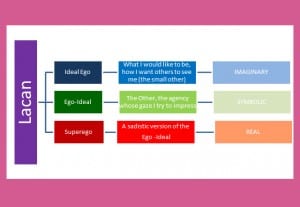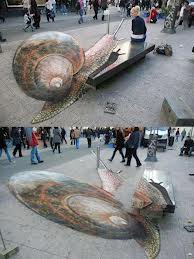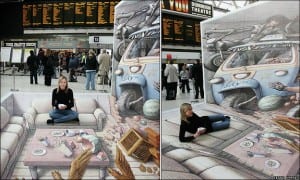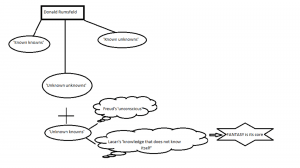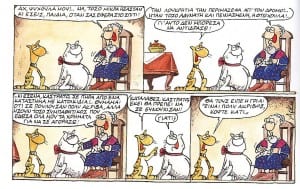5. Ego, Ideal and Superego: Lacan as a Viewer of Casablanca
“Nothing forces anyone to enjoy except the Supergo. The Superego is the imperative of jouissance – Enjoy!”
Right from the start, I knew I was going to enjoy (haha!!) this chapter! It interests me very much to ponder upon the degrees of enjoyment from the slight hint of a smile to the notion of “it hurts but I like it” and all the levels of consciousness that could apply to…
When speaking of jouissance the distinction is made: it speaks of an enjoyment so intense that it is borderline painful and pleasurable; a traumatic DUTY to enjoy, linked to Freud’s superego that “sadistic ethical agency that bombards us with impossible demands and then gleefully observes our failure to meet them”. I have to say that I LOVE this definition especially the concept of an invisible “superagency” gleefully observing us stumble about, like kids watching a cartoon and laughing at the hero’s mishaps!
So let us bullet-point the Freudian and then the Lacanian (more distinct) concept of the three agencies that propel a subject to act ethically.
In the eyes of the Superego the more I try to suppress my corrupt urges, the more guilty I become, as, according to Lacan, it is an anti-ethical agency. Lacan proposes therefore a fourth agency, the ‘law of desire’ the agency urging us to act according to our desire. He also notes that there is a rift between this law of desire and the Ego-Ideal (the goody two shoes of agencies telling us to be reasonable and abide the norms of society) and that is where the superego comes in handy. It feeds us with guilt, not so much for the “sinful things we’ve done” but as a reminder that we have betrayed our desire.
Coming then to the movie Casablanca there is 3 ½ minute open-ended part, where the viewer is called to decide for himself whether or not the two main characters had sex or not. There are indications as to both. This serves as a clear example of keeping decorum in the eyes of the big Other but leaving fantasy free to roam! As long as it is not clearly stated that the two characters engaged in sexual relations the viewer can deny it on the Ego-Ideal level and thus be “safe” from judgment. On the other hand, on the phantasmic realm of imagination the viewer is free to indulge in his deepest darkest fantasies and – best of all – guiltless! This is for Lacan the purest case of inherent transgression and the proof that appearances do matter…
In closing a few more viewpoints are provided, starting with the Hays Production Code that according to Foucault, was more productive, creating the very excess whose depiction it forbade and less negative censorship. By direct prohibition the opposite result was reached, everything became sexualized (yes, the human being desires what it is told it cannot have!). Then there is Shakespeare’s Ulysses where Ulysses diplomatically states the necessity of keeping the hierarchy (keeping the Ego-Ideal happy) while at the same time manipulating Achilles’s envy and playing him against others feeding from his desire (and that makes the superego happy since it loves a good catfight…). Finally in A Few Good Men, Apocalypse Now but also in the debate about the fate of the Guantanamo prisoners one thing is common: if it is not seen, if it is kept secret than it is as if it did not happen… Power can do wonderfully horrible things without admitting to them, or even worse, with presenting them as a solution for the best (and actually believing it sometimes). And then there are those men (or groups, or animals, or concepts) that would have been better off dead than being left for alive in the realm of the un-dead…
What comes to mind…
“Television”: Lacan on the unconscious
http://www.youtube.com/watch?v=URsYj-TVFjc
slavoj zizek gangnam style
http://www.youtube.com/watch?v=cP6LoH3hASo
‘Everybody in Guantanamo has been tortured or abused’ – former detainee
http://alethonews.wordpress.com/tag/guantanamo-bay-detention-camp/
Donald’s better self 1938
http://www.youtube.com/watch?v=aDLWbBrvA40
Casablanca’s 3 1/2 minutes…
https://www.facebook.com/photo.php?v=10151608569705748&saved
A Few Good Men – You Can’t Handle the TRUTH
http://www.youtube.com/watch?v=iUu4ceCIN4k
Less artists than I wanted… I need to sleeeep….
SUKA OFF “tranSfera” | VENICE INTERNATIONAL PERFORMANCE ART WEEK 2012
http://www.youtube.com/watch?v=8pFjXTsEQdU –> Jouissance, more pain than pleasure…
Live Video: Enter at your own jouissance. (Jan Baracz hands a tissue to Arfus Greenwood)
http://post.thing.net/node/2335
Jouissance Invitation Tease
Tim Minchin – Guilty Pleasures
http://www.youtube.com/watch?v=rVsD-bHA7oA –> a funny take on the superego’s guilty pleasures… (the law of desire)

